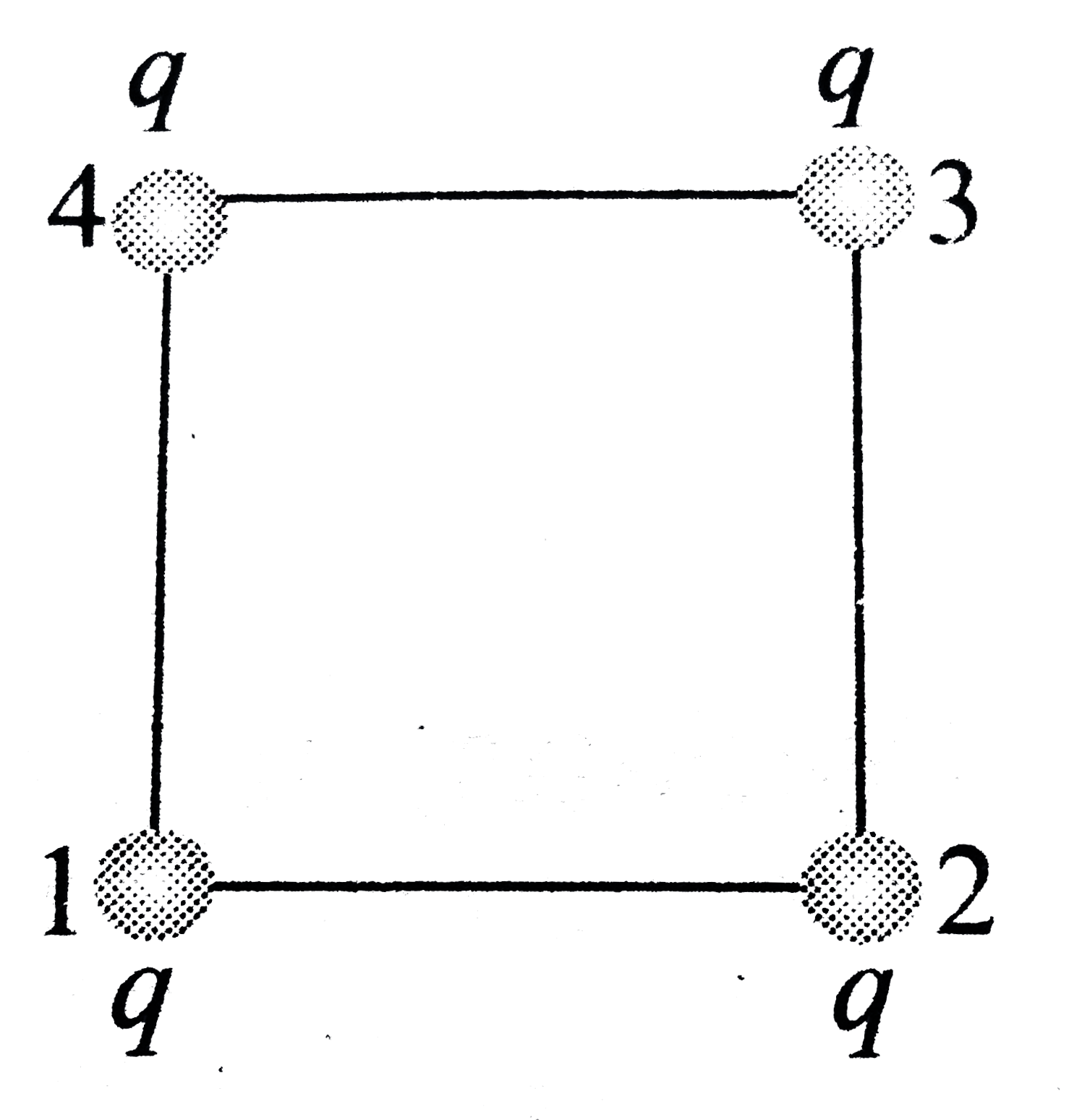Four bodies each of mass m are placed at the different corners of a square of side a. find the work done on the system to take any one body to infinity.
To find the work done on the system to take any one body to infinity, we can follow these steps:
Step 1: Calculate the Initial Potential Energy of the System
The potential energy U between two masses m1 and m2 separated by a distance r is given by the formula:
U=−Gm1m2r
In our case, we have four masses m at the corners of a square with side length a. We need to calculate the potential energy for all pairs of masses.
1. Pairs on the sides of the square: There are 4 pairs of adjacent masses, each separated by a distance a:
Uside=4(−Gm2a)=−4Gm2a
2. Pairs on the diagonals: There are 2 pairs of masses on the diagonals, each separated by a distance √2a:
Udiagonal=2(−Gm2√2a)=−2Gm2√2a
Combining these, the total initial potential energy Ui of the system is:
Ui=−4Gm2a−2Gm2√2a
Step 2: Calculate the Final Potential Energy After Moving One Mass to Infinity
When one mass is moved to infinity, only three masses remain at the corners of the square. We need to calculate the potential energy of these three masses.
1. Remaining pairs on the sides: There are 3 pairs of adjacent masses:
Ufinal side=3(−Gm2a)=−3Gm2a
2. Remaining pairs on the diagonal: There is 1 pair of masses on the diagonal:
Ufinal diagonal=1(−Gm2√2a)=−Gm2√2a
Thus, the total final potential energy Uf of the system is:
Uf=−3Gm2a−Gm2√2a
Step 3: Calculate the Work Done
The work done W on the system to take one body to infinity is given by the change in potential energy:
W=Uf−Ui
Substituting the expressions for Uf and Ui:
W=(−3Gm2a−Gm2√2a)−(−4Gm2a−2Gm2√2a)
Simplifying this:
W=−3Gm2a−Gm2√2a+4Gm2a+2Gm2√2a
W=(1Gm2a)+(1Gm2√2a)
Thus, the final expression for the work done is:
W=Gm2a+Gm2√2a
Final Answer
The work done on the system to take any one body to infinity is:
W=Gm2a+Gm2√2a
The potential energy U between two masses m1 and m2 separated by a distance r is given by the formula:
U=−Gm1m2r
In our case, we have four masses m at the corners of a square with side length a. We need to calculate the potential energy for all pairs of masses.
Uside=4(−Gm2a)=−4Gm2a
Udiagonal=2(−Gm2√2a)=−2Gm2√2a
Ui=−4Gm2a−2Gm2√2a
When one mass is moved to infinity, only three masses remain at the corners of the square. We need to calculate the potential energy of these three masses.
Ufinal side=3(−Gm2a)=−3Gm2a
Ufinal diagonal=1(−Gm2√2a)=−Gm2√2a
Uf=−3Gm2a−Gm2√2a
The work done W on the system to take one body to infinity is given by the change in potential energy:
W=Uf−Ui
W=(−3Gm2a−Gm2√2a)−(−4Gm2a−2Gm2√2a)
W=−3Gm2a−Gm2√2a+4Gm2a+2Gm2√2a
W=(1Gm2a)+(1Gm2√2a)
W=Gm2a+Gm2√2a
The work done on the system to take any one body to infinity is:
W=Gm2a+Gm2√2a
Topper's Solved these Questions
- GRAVITATIONBook:ALLENChapter:GRAVITATIONExercise:BOX-1
Explore 3 Videos
- GRAVITATIONBook:ALLENChapter:GRAVITATIONExercise:BOX-2
Explore 13 Videos
- GRAVITATIONBook:ALLENChapter:GRAVITATIONExercise:Exercise 5 B (Previous Year Questions)
Explore 9 Videos
- GEOMETRICAL OPTICSBook:ALLENChapter:GEOMETRICAL OPTICSExercise:subjective
Explore 14 Videos
- KINEMATICS-2DBook:ALLENChapter:KINEMATICS-2DExercise:Exercise (O-2)
Explore 46 Videos
Similar Questions
Four particles each of mass 'm' are placed at the four vertices of a square 'a' .Find net force on any one the particle.
View SolutionFour particles each of mass 'm' are kept at the four corners of a square of edge 'a'. Find the moment of inertia of the system about a line perpendicular to the plane of the square and passing through the center of the square.
View Solution
Knowledge Check
Four particles each of mass m are placed at the vertices of a square of side l. the potential at the centre of square is
A−√2Gm2l(2−1√2)B−2Gm2l(2+1√2)C−√2Gm2l(√2−1√2)D−2Gm2l(√2−1√2)
A point charge Q is placed at the corner of a square of side a. Find the flux through the square.
View SolutionFour identical point charges q are placed at four corners of a square of side a. Find the potential energy of the charge system.
 .
.
View SolutionThree particle of mass m each are placed at the three corners of an equilateral triangle of side a. Find the work which should be done on this system to increase the sides of the triangle to 2a.
View SolutionThree particle of mass m each are placed at the three corners of an equilateral triangle of side a. Find the work which should be done on this system to increase the sides of the triangle to 2a.
View SolutionThree particle of mass m each are placed at the three corners of an equilateral triangle of side a. Find the work which should be done on this system to increase the sides of the triangle to 2a.
View SolutionThree particle of mas m each are placed at the three corners of an equlateral triangle of side a. Find the work which should be done on this system to increase the sides of the triangle to 2a.
View SolutionThe moment of inertia of a system of four rods, each of length l and mass m, about the axis shown is:

View Solution
